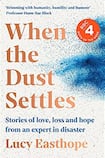
Our lives are all punctuated by culture-changing disaster events. If you were conscious when 9/11 occurred, you will recall where you were when a plane crashed into the north tower of the World Trade Center. You’ll recall witnessing an event that removed us from “before” and plunged us into “after”.
Lucy Easthope, the UK’s leading authority on disaster recovery, understands this division of reality in a way that few people ever could. In the wake of 9/11, she was tasked with assembling a team of mortuary and funeral personnel to work at Ground Zero and in facilities storing the human remains and personal effects of victims. This new memoir is an astonishingly thorough account of the elements of disaster we don’t see. She exposes readers to the planning and recovery stages of the worst imaginable natural and man-made occurrences.
The chronology of Easthope’s life is marked by hundreds of catastrophic events, the types most people won’t see one of first-hand in their lifetime – from sunken ships, floods, train and plane crashes to the 7/7 bombings, the 2004 Indian Ocean earthquake and tsunami, the Iraq War, the Fukushima nuclear disaster, the Grenfell Tower fire and, most recently, the Covid-19 pandemic.
Her unusual interest in disaster began early. A native Liverpudlian, she credits the impact of the 1989 Hillsbrough disaster – the stadium crush in which 94 football fans were killed, with three more deaths followingt – as an experience which changed her at just 10 years old. The complex and lasting impact on her parents, community and schoolmates made her “understand that terrible things can happen but also that the people in charge – the state and its agencies – make terrible mistakes. And when they do, it is often the communities that have already been failed who are blamed.”
Easthope went on to study law and take a master’s degree in disaster management. She secured a job with a company called Kenyon International Emergency Services, which provides response and recovery services around the world, assisting governments and private companies such as airlines with “the right equipment and data management tools to meet the demands of any incident”.
It was in this capacity that Easthope found herself at Ground Zero after 9/11 among countless other disasters, and where she gained the experience that would inform her unusual academic specialty. The book recreates her experience so richly that to read it is to move inside a world in which one’s lived experience is divided not by relatable mundanities peppered with suffering, but to go from one instance of ruinous chaos and tragedy to the next.
Easthope conveys the wretched physicality without veering into vulgarity or callousness. Still, she is frank in the extreme
Easthope’s is an entirely unique vision of the human experience. The macabre texture of mayhem and death is generally kept out of public discussion as a result of the sense of distaste and discomfort it may evoke or due to security concerns. Through media and the blanched language of politics, we are shielded from the practicalities of disaster, but Easthope manages to convey the wretched physicality without veering into vulgarity or callousness.
Still, she is frank in the extreme. The book is written, unsurprisingly, with the kind but unrelenting tone of someone well versed in delivering bad news. It is a challenging read, relaying countless anecdotes that expose the inherent friction and humanity in caring for the dead and investing in our flawed reality.
Easthope writes of attempting to identify the remains of British soldiers repatriated from Iraq when there were only feet left behind. These, she says, were sometimes still wearing strangely undersized desert boots. She discovered that some British soldiers had bought the ill-fitting boots from their American counterparts and writes: “I have never been able to put out of my mind that they were sent to war without the boots that they needed.”
Such metacommentary is common as Easthope balances her influence on and role within the infrastructure of disaster response with its good intentions and inevitable shortcomings.
Accounts of disaster are juxtaposed with stories of the author’s challenging personal life. She details system failures and injustices while sharing stories of her own experience with multiple miscarriages and ill fortune – terrible police protocols that cause further harm to bereaved families, disrespect for the personal effects of people who have died in natural disasters or terrorist incidents, and systemic prejudice and incompetence.
Easthope’s gender impacts her experience in disaster planning and relief, not always for the better, and this too is examineds. Through all this, however, the optimism of her life and work filters through, as does the unusual and touching gentleness she feels toward the deceased, for whom she displays no fear or horror in any condition, and whose entitlement to dignity, even in disaster, and right to be returned to loved ones she spiritedly defends.
She reveals what we might have expected if we had stopped to think about it
Easthope has pioneered methods that maximise the virtues of courage, respect and dignity in scenarios where those virtues are standardly obliterated by panic and instinct. She is – sometimes literally in the context of the book, but also figuratively – the person with a comforting demeanour, a calm tone and a strong cup of tea when things are at their most bleak.
Here Easthope asks questions that reveal the messiness of procedures most
of us simply presume to be rigorous and definitive. She reveals what we might have expected if we had stopped to think about it. Human beings are as flawed and vulnerable in disasters as in everything else. A plan is only as useful as the authorities tasked with actualising it are prepared, interested and sincere.
However, the sincerity of the people on the ground radiates through the book –
the people who remain long after the climax of initial disaster. People such as Lucy Easthope, who dwell in the places most of us can only imagine.












